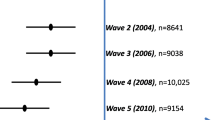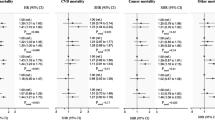Abstract
Purpose
The aim of this paper was to analyze the effect of biomedical and psychosocial well-being, based on distinct successful aging models (SA), on time to mortality, and determine whether this effect was modified by socioeconomic status (SES) in a nationally representative sample of older Spanish adults.
Methods
Data were taken from a 3-year follow-up study with 2783 participants aged 50 or over. Vital status was ascertained using national registers or asking participants’ relatives. Kaplan–Meier curves were used to estimate the time to death by SES, and levels of biomedical and psychosocial SA. Cox proportional hazard regression models were conducted to explore interactions between SES and SA models while adjusting for gender, age, and marital status.
Results
Lower levels of SES and biomedical and psychosocial SA were associated with low probability of survival. Only the interaction between SES and biomedical SA was significant. Biomedical SA impacted on mortality rates among individuals with low SES but not on those with medium or high SES, whereas psychosocial SA affected mortality regardless of SES.
Conclusions
Promoting equal access to health care system and improved psychosocial well-being could be a protective factor against premature mortality in older Spanish adults with low SES.


Similar content being viewed by others
References
Lynch J, Kaplan GA (2000) Socioeconomic position. In: Berkman L, Kawachi I (eds) Social epidemiology. Oxford, New York, pp 13–35
Lantz PM, Golberstein E, House JS, Morenoff J (2010) Socioeconomic and behavioral risk factors for mortality in a national 19-year prospective study of U.S. adults. Soc Sci Med 70:1558–1566
Fried LP, Kronmal RA, Newman AB et al (1998) Risk factors for 5-year mortality in older adults: the cardiovascular health study. J Am Med Assoc 279:585–592
Faggiano F, Partanen T, Kogevinas M, Boffetta P (1997) Socioeconomic differences in cancer incidence and mortality. IARC Sci Publ 138:65–176
Adler NE, Newman K (2002) Socioeconomic disparities in health: pathways and policies. Health Aff (Millwood) 21:60–76
Blane D, Smith GD, Bartley M (1993) Social selection: what does it contribute to social class differences in health? Sociol Heal Illn 15:1–15
van Oort FVA, van Lenthe FJ, Mackenbach JP (2005) Material, psychosocial, and behavioural factors in the explanation of educational inequalities in mortality in The Netherlands. J Epidemiol Community Health 59:214–220
Skalická V, Van Lenthe F, Bambra C, Krokstad S, Mackenbach J (2009) Material, psychosocial, behavioural and biomedical factors in the explanation of relative socio-economic inequalities in mortality: evidence from the HUNT study. Int J Epidemiol 38(5):1272–1284
Schrijvers CT, Stronks K, van de Mheen HD, Mackenbach JP (1999) Explaining educational differences in mortality: the role of behavioral and material factors. Am J Public Health 89(4):535–540
Phelan JC, Link BG, Diez-Roux A et al (2004) “Fundamental causes” of social inequalities in mortality: a test of the theory. J Health Soc Behav 45:265–285
Lazzarino AI, Hamer M, Stamatakis E, Steptoe A (2013) The combined association of psychological distress and socioeconomic status with all-cause mortality: a national cohort study. JAMA Intern Med 173:22–27
Van Oeffelen AAM, Agyemang C, Bots ML et al (2012) The relation between socioeconomic status and short-term mortality after acute myocardial infarction persists in the elderly: results from a nationwide study. Eur J Epidemiol 27:605–613
Bowling A, Dieppe P (2005) What is successful ageing and who should define it? BMJ 331:1548–1551
Cosco TD, Prina a M, Perales J et al (2013) Operational definitions of successful aging: a systematic review. Int Psychogeriatr 26:1–9
Perales J, Martin S, Ayuso-Mateos JL et al (2014) Factors associated with active aging in Finland, Poland, and Spain. Int Psychogeriatr 1–13
Domènech-Abella J, Perales J, Lara E et al (2017) Sociodemographic factors associated with changes in successful aging in Spain: a follow-up study. J Aging Health 89826431771432
Jang S, Choi Y, Kim D (2009) Association of socioeconomic status with successful ageing: differences in the components of successful ageing. J Biosoc Sci 41:207–219
Chen E, Miller GE (2013) Socioeconomic status and health: Mediating and moderating factors. Annu Rev Clin Psychol 9:723–749
Hudson CG (2005) Socioeconomic status and mental illness: tests of the social causation and selection hypotheses. Am J Orthopsychiatry 75:3–18
Pinquart M, Sörensen S (2000) Influences of socioeconomic status, social network, and competence on subjective well-being in later life: a meta-analysis. Psychol Aging 15:187–224
Gu D (2015) Concordance and discordance between objectively and subjectively measured successful aging and their linkages with mortality. Int J Popul Stud 1:29–41
Leonardi M, Chatterji S, Koskinen S et al (2014) Determinants of health and disability in ageing population: the COURAGE in Europe project (collaborative research on ageing in Europe). Clin Psychol Psychother 21:193–198
Üstun TB, Chatterji S, Mechbal A, Murray CJL (2005) Quality assurance in surveys: standards, guidelines and procedures. In: Household surveys in developing and transition countries. UN, New York, pp 199–230
Moussavi S, Chatterji S, Verdes E et al (2007) Depression, chronic diseases, and decrements in health: results from the world health surveys. Lancet 370:851–858
Grundy E, Holt G (2001) The socioeconomic status of older adults: how should we measure it in studies of health inequalities? J Epidemiol Community Health 55:895–904
Darin-Mattsson A, Fors S, Kåreholt I (2017) Different indicators of socioeconomic status and their relative importance as determinants of health in old age. Int J Equity Health 16:173
Dowd JB, Zajacova A (2007) Does the predictive power of self-rated health for subsequent mortality risk vary by socioeconomic status in the US? Int J Epidemiol 36:1214–1221
Garin N, Koyanagi A, Chatterji S et al (2016) Global multimorbidity patterns: a cross-sectional, population-based, multi-country study. J Gerontol A Biol Sci Med Sci 71:205–214
Basu S, Millett C (2013) Social epidemiology of hypertension in middle-income countries novelty and significance. Hypertension 62:18–26
World Health Organization (2012) The World Health Organization Disability Assessment Schedule II (WHODAS II). http://www.who.int/icidh/whodas/index.html. Accessed 09 Jan 2018
Haro JM, Arbabzadeh-Bouchez S, Brugha TS et al (2006) Concordance of the composite international diagnostic interview version 3.0 (CIDI 3.0) with standardized clinical assessments in the WHO world mental health surveys. Int J Methods Psychiatr Res 15:167–180
American Psychiatric Association (1994) Diagnostic and statistical manual of mental disorder, 4th edn. American Psychiatric Association, Washington, DC
He W, Muenchrath MN, Kowal PR (2012). Shades of gray: a cross-country study of health and well-being of the older populations in SAGE countries, 2007–2010. US Department of Commerce, Economics and Statistics Administration, US Census Bureau
Armstrong T, Bull F (2006) Development of the World Health Organization global physical activity questionnaire (GPAQ). J Public Health (Bangkok) 14:66–70
Global Physical Activity Questionnaire (GPAQ) Analysis guide. http://www.who.int/chp/steps. Accessed 25 April 2017
Bøen H, Dalgard O, Bjertness E et al (2012) The importance of social support in the associations between psychological distress and somatic health problems and socio-economic factors among older adults living at home: a cross sectional study. BMC Geriatr 12:27
Cosco TD, Prina AM, Perales J et al (2013) Lay perspectives of successful ageing: a systematic review and meta-ethnography. BMJ Open 3:196–200
Cosco TD, Matthew Prina A, Perales J et al (2014) Whose” successful ageing”?: lay-and researcher-driven conceptualisations of ageing well. Eur J Psychiatry 28:124–130
Krieger N, Williams DR, Moss NE (1997) Measuring social class in US public health research: concepts, methodologies, and guidelines. Annu Rev Public Health 18:341–378
Diemer MA, Mistry RS, Wadsworth ME et al (2013) Best practices in conceptualizing and measuring social class in psychological research. Anal Soc Issues Public Policy 13:77–113
Blishen BR, Carroll WK, Moore C (1987) The 1981 socioeconomic index for occupations in Canada. Can Rev Sociol 24:465–488
Freeman A, Tyrovolas S, Koyanagi A et al (2016) The role of socio-economic status in depression: results from the COURAGE (aging survey in Europe). BMC Public Health 16:1098
Katsarou A, Tyrovolas S, Psaltopoulou T et al (2010) Socio-economic status, place of residence and dietary habits among the elderly: the Mediterranean islands study. Public Health Nutr 13:1614–1621
Lidfeldt J, Li TY, Hu FB et al (2007) A prospective study of childhood and adult socioeconomic status and incidence of type 2 diabetes in women. Am J Epidemiol 165:882–889
Meltzer H, Bebbington P, Brugha T et al (2013) The relationship between personal debt and specific common mental disorders. Eur J Public Health 23:108–113
Riumallo-Herl C, Basu S, Stuckler D et al (2014) Job loss, wealth and depression during the great recession in the USA and Europe. Int J Epidemiol 43:1508–1517
Adda J, Banks J, von Gaudecker H-M (2009) The impact of income shocks on health: evidence from cohort data. J Eur Econ Assoc 7:1361–1399
Pickett KE, Wilkinson RG (2015) Income inequality and health: a causal review. Soc Sci Med 128:316–326
Giovanella L, Stegmüller K (2014) The financial crisis and health care systems in Europe: universal care under threat? trends in health sector reforms in Germany, the United Kingdom, and Spain. Cad Saude Publica 30:2263–2281
Karanikolos M, Mladovsky P, Cylus J et al (2013) Financial crisis, austerity, and health in Europe. Lancet 381:1323–1331
Burstin HR, Lipsitz SR, Brennan TA (1992) Socioeconomic status and risk for substandard medical care. J Am Med Assoc 268:2383–2387
Aguilar-Palacio I, Carrera-Lasfuentes P, Solsona S et al (2016) Health-care utilization in elderly (Spain 2006–2012): influence of health status and social class. Aten Primaria 48:235–243
Stafford M, De Silva M, Stansfeld S, Marmot M (2008) Neighbourhood social capital and common mental disorder: testing the link in a general population sample. Health Place 14:394–405
Marmot M, Bell R (2012) Fair society, healthy lives. Public Health 126:S4–S10
Olaya B, Domènech-abella J, Victoria M et al (2017) All-cause mortality and multimorbidity in older adults: the role of social support and loneliness. Exp Gerontol 99:120–126
Kriegsman DMW, Penninx BWJH., Van Eijk JTM et al (1996) Self-reports and general practitioner information on the presence of chronic diseases in community dwelling elderly. J Clin Epidemiol 49:1407–1417
Liang J, Lawrence RH, Bennett JM, Whitelaw NA (1990) Appropriateness of composites in structural equation models. J Gerontol 45:S52-S59
McKee M, Karanikolos M, Belcher P, Stuckler D (2012) Austerity: a failed experiment on the people of Europe. Clin Med 12:346–350
Aznar-Lou I (2017) The problem of non-initiation of drug treatment: evaluation with quantitative methods. Article in Spanish (Doctoral thesis, Universitat de Barcelona, Spain). http://www.tesisenred.net/handle/10803/404327. Accessed 25 April 2017
Acknowledgements
This work was supported by the European Community’s Seventh Framework Programme [Grant No. 223071-COURAGE study]; the Instituto de Salud Carlos III-FIS [Grant Nos. PS09/00295, PS09/01845, PI12/01490, and PI13/00059] [Projects PI12/01490 and PI13/00059 were co-funded by the European Union European Regional Development Fund (ERDF) “A Way to Build Europe”]; the European Union’s Horizon 2020 Research and Innovation Programme [Grant Agreement 635316]; and the Centro de Investigación Biomédica en Red de Salud Mental (CIBERSAM), Instituto de Salud Carlos III. Data on households were provided by the Spanish Statistical Office. Joan Domènech-Abella’s work is supported by the FPU predoctoral Grant (FPU16/05209) from the Spanish Ministry of Education, Culture and Sports. We thank Stephen Kelly for the help in English language editing.
Author information
Authors and Affiliations
Corresponding author
Ethics declarations
Conflict of interest
The authors declared no potential conflicts of interest with respect to the research, authorship, and/or publication of this article.
Rights and permissions
About this article
Cite this article
Doménech-Abella, J., Mundó, J., Moneta, M.V. et al. The impact of socioeconomic status on the association between biomedical and psychosocial well-being and all-cause mortality in older Spanish adults. Soc Psychiatry Psychiatr Epidemiol 53, 259–268 (2018). https://doi.org/10.1007/s00127-018-1480-7
Received:
Accepted:
Published:
Issue Date:
DOI: https://doi.org/10.1007/s00127-018-1480-7




